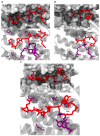14-3-3: A Case Study in PPI Modulation
- PMID: 29890630
- PMCID: PMC6099619
- DOI: 10.3390/molecules23061386
14-3-3: A Case Study in PPI Modulation
Abstract
In recent years, targeting the complex network of protein⁻protein interactions (PPIs) has been identified as a promising drug-discovery approach to develop new therapeutic strategies. 14-3-3 is a family of eukaryotic conserved regulatory proteins which are of high interest as potential targets for pharmacological intervention in human diseases, such as cancer and neurodegenerative and metabolic disorders. This viewpoint is built on the “hub” nature of the 14-3-3 proteins, binding to several hundred identified partners, consequently implicating them in a multitude of different cellular mechanisms. In this review, we provide an overview of the structural and biological features of 14-3-3 and the modulation of 14-3-3 PPIs for discovering small molecular inhibitors and stabilizers of 14-3-3 PPIs.
Keywords: 14-3-3 PPIs; PPI modulation; small molecules.
Conflict of interest statement
The authors declare no conflict of interest.
Figures







Similar articles
-
Small molecules modulation of 14-3-3 protein-protein interactions.Drug Discov Today Technol. 2013 Dec;10(4):e541-7. doi: 10.1016/j.ddtec.2012.10.001. Drug Discov Today Technol. 2013. PMID: 24451646 Review.
-
Modulators of 14-3-3 Protein-Protein Interactions.J Med Chem. 2018 May 10;61(9):3755-3778. doi: 10.1021/acs.jmedchem.7b00574. Epub 2017 Oct 19. J Med Chem. 2018. PMID: 28968506 Free PMC article. Review.
-
Reconstructing genome-wide protein-protein interaction networks using multiple strategies with homologous mapping.PLoS One. 2015 Jan 20;10(1):e0116347. doi: 10.1371/journal.pone.0116347. eCollection 2015. PLoS One. 2015. PMID: 25602759 Free PMC article.
-
Stabilization and inhibition of protein-protein interactions: the 14-3-3 case study.ACS Chem Biol. 2013 Jan 18;8(1):27-35. doi: 10.1021/cb300599t. Epub 2012 Dec 14. ACS Chem Biol. 2013. PMID: 23210482 Review.
-
Stabilization of Protein-Protein Interactions in chemical biology and drug discovery.Prog Biophys Mol Biol. 2015 Oct;119(1):10-9. doi: 10.1016/j.pbiomolbio.2015.05.002. Epub 2015 Jun 18. Prog Biophys Mol Biol. 2015. PMID: 26093250 Review.
Cited by
-
14-3-3σ and Its Modulators in Cancer.Pharmaceuticals (Basel). 2020 Dec 3;13(12):441. doi: 10.3390/ph13120441. Pharmaceuticals (Basel). 2020. PMID: 33287252 Free PMC article. Review.
-
Mechanistic Insights into the Function of 14-3-3 Proteins as Negative Regulators of Brassinosteroid Signaling in Arabidopsis.Plant Cell Physiol. 2024 Nov 13;65(10):1674-1688. doi: 10.1093/pcp/pcae056. Plant Cell Physiol. 2024. PMID: 38783418 Free PMC article.
-
The role of 14-3-3 proteins in cell signalling pathways and virus infection.J Cell Mol Med. 2021 May;25(9):4173-4182. doi: 10.1111/jcmm.16490. Epub 2021 Apr 1. J Cell Mol Med. 2021. PMID: 33793048 Free PMC article. Review.
-
Different phosphorylation and farnesylation patterns tune Rnd3-14-3-3 interaction in distinct mechanisms.Chem Sci. 2021 Jan 26;12(12):4432-4442. doi: 10.1039/d0sc05838f. Chem Sci. 2021. PMID: 34163708 Free PMC article.
-
Involvement of activator protein-1 family members in β-catenin and p300 association on the genome of PANC-1 cells.Heliyon. 2022 Feb 2;8(2):e08890. doi: 10.1016/j.heliyon.2022.e08890. eCollection 2022 Feb. Heliyon. 2022. PMID: 35198763 Free PMC article.
References
-
- Moore B.W., Perez V.J., Carlson F.D., editors. Physiological and Biochemical Aspects of Nervous Integration. Prentice-Hall Inc.; The Marine Biological Laboratory; Woods Hole, MA, USA: 1967. pp. 343–359.
-
- Ichimura T., Isobe T., Okuyama T., Takahashi N., Araki K., Kuwano R., Takahashi Y. Molecular cloning of cDNA coding for brain-specific 14-3-3 protein, a protein kinase-dependent activator of tyrosine and tryptophan hydroxylases. Proc. Natl. Acad. Sci. USA. 1988;85:7084–7088. doi: 10.1073/pnas.85.19.7084. - DOI - PMC - PubMed
Publication types
MeSH terms
Substances
LinkOut - more resources
Full Text Sources
Other Literature Sources

